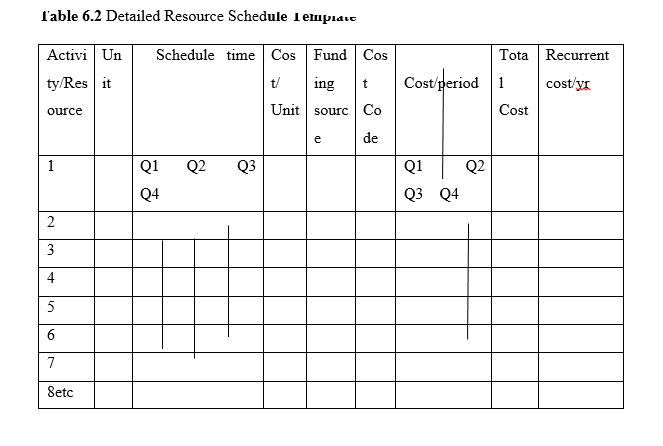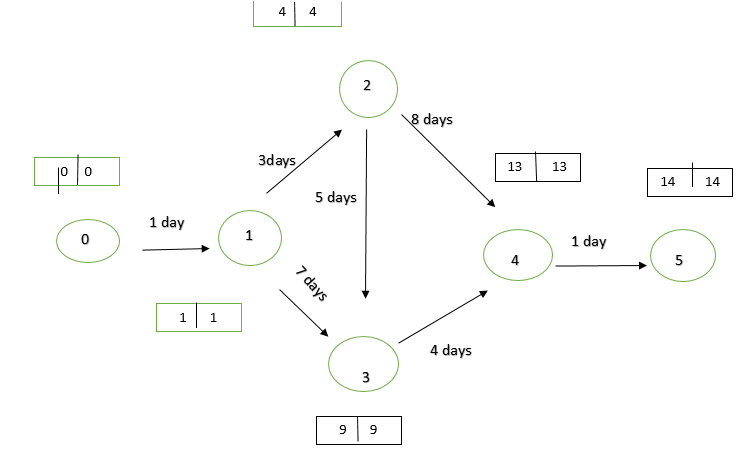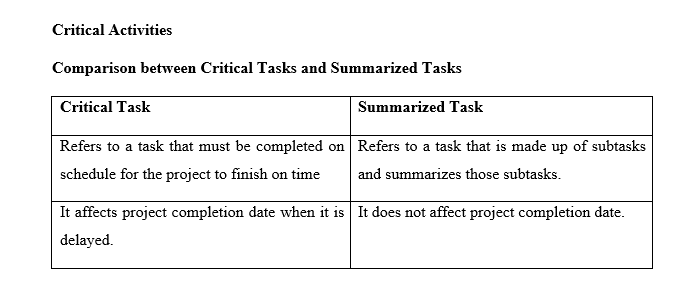Project Scheduling
Project scheduling is a step in planning which involves determining the dates for performing schedule activities and the planned dates for meeting schedule milestones- i.e. Determining when, after how long, what to be done, who and why has been determined in the preceding planned activities – what has to be done, when, where, by who and how. Scheduling involves time scheduling and resources scheduling. Different tools are used for doing this, among them the logical framework.
Activity and Resource Schedules
An activity schedule is a method of presenting the activities of a project, which identifies their logical sequence and any dependencies that exist between them and provides a basis for allocating management responsibility for completing each activity. A WBS and constraint work packages become the basis for project planning, scheduling and controlling.
A Checklist for Preparing an Activity Schedule
Once the Log frame itself is complete, it is then possible to copy the activities from the left hand column into an activity-scheduling format. The format can be adopted to fit with the expected duration of the project in question. The first year’s activities may be specified more in detail (showing the start and finish of activities to within a week of their expected timing) while subsequent years scheduling should usually be more indicative (to within a month). These are just preliminary estimates that will subsequently be revised by project manager in the light of actual implementation performance. They nevertheless provide an important initial benchmark, and aid the preparation of input and cost schedules.
A step-by-step approach can be followed:
Step 1 – List Main Activities
The main activities in the Log frame are a summary of what the project must do in order to achieve project objectives.
Step-2 Break Activities Down Into Manageable Tasks
The purpose of breaking activities down into sub-activities or tasks is to make them sufficiently simple to be organized and managed easily.
The technique is to break an activity down to its component sub-activities, and then to take each sub-activity and to break it down into its component tasks. Each task can thn be assigned to an individual, and becomes their short-term goal.
The main skill is in getting the level of detail right. The most common mistake is to break the activities down into too much detail. This breakdown should stop as soon as the planner has sufficient detail to estimate the time and resources required, and the person responsible for actually doing the work has sufficient instructions on what has to be done.
Step 3 – Clarify Sequence and Dependencies
Once the activities have been broken down into sufficient detail, they must be related to each othertodeterminetheir:
- Sequence – in what order should related activities be undertaken
- Dependencies – is the activity dependent on the start-up or completion of any other activity
Eg. Building a house consists of a number of separate, but inter-related activities: digging and laying the foundations; erecting the walls; installing the doors and windows; plastering the walls; constructing the roof; installing the plumbing.
The sequence dictates that digging the foundations comes before building the walls; while dependencies include the fact that you cannot start installing the doors and windows until the walls have reached a certain height; or you cannot finish plastering until the plambing has been fully installed. Dependencies may also occur between otherwise unrelated activities that will be undertaken by the same person.
Step 4 – Estimate Start-up, Duration and Completion of Activities
Specifying the timing means making a realistic estimate of the duration of each task, and then building it into the activity schedule to establish likely start-up and completion dates, often though it is not possible to estimate timing with complete confidence. Inaccuracy is a common mistake, usually resulting in an underestimate of the time required, and can arise for a number of reasons:
- Omission of essential activities and tasks
- Failure to allow sufficiently for interdependence of activities
- Failure to allow for resource competition (i.e. Scheduling the same person or piece of equipment to do two or more things at once)
- A desire to impress with the promise of rapid results
- Lack of consultation with members with technical skills and experience.
Step-5- Summarize Scheduling on Main Activities
Having specified the timing of individual tasks that make up the main activities, it is useful to provide an overall summary of the startup, duration and completion of the main activity itself.
Step-6-Define Milestones
Milestones provide the basis by which project implementation is monitored and managed. They are key events that provide a measure of progress and a target for the project team to aim at. The simplest milestones are the dates estimated for completion of each activity – eg. Training needs assessment completed by January 2012.
Step 7 – Define Expertise Requirements
When the tasks are known, it is possible to specify the type of expertise required. Often the available expertise is known in advance.
Step 8 – Allocate Tasks among Team
This involves more than just saying who does what. With task allocation comes responsibility for achievement of milestones. In other words, it is a means of defining each team member’s accountability – to the project manager and to other team members.
Task allocation must therefore take into account the capability, skills and expertise of each member of the team. When delegating tasks to team members, it is important to ensure that they understand what is required of them. If not, the level of detail with which the relevant tasks are specified may have to be increased.
Presenting an Activity Schedule
All of the information in an activity schedule can be summarized in graphical format. See the Gantt chart above. The format can be adapted to fit with the expected duration of the project. An overall project schedule may only specify activities on a quarterly or monthly basis, while an individual’s quarterly work plan may use a weekly format as shown below.

Preparing Resources Schedules
Cost estimates must be based on careful and thorough budgeting.
They will have significant influence over the investment decision at project appraisal and subsequently on the smooth implementation of the project if the go-ahead is given. Again, the list of activities should be copied into an input and cost schedule pro-forma. Each activity should be then used as a checklist to ensure that all necessary means falls under that activity are provided for.
- A Checklist For Specifying Means and Scheduling Costs
Once the activities have been entered into the schedule, the means necessary to undertake the activities must be specified. As there will be a need to aggregate or summarize the cost information, the means should be allocated to establish cost categories.
- For example, in Figure 24 the activity of establishing a Planning Unit requires Equipment and Salaries and Allowances.
- The Units, Quantity per Period, and estimated Unit Costs should then be specified. If entered on a spreadsheet, Costs per Period and Total
- Project Costs can be calculated using simple formulae.
- Project Costing should allow the allocations of costs between the different funding sources so that each party is clear about their respective contributions.
- The code for Funding Source can then be used to sort all the cost and to determine for each established cost category. By specifying the Cost Code, costs can again be sorted to determine total costs by cost category.
- It is now possible to Schedule Costs using simple formulae to multiply the annual quantity by the unit cost. Once Total Costs have been calculated, it is important to remember that the implementing agency will be required to meet any recurrent costs of maintaining service provision beyond the life of the project.
- Recurrent Costs may be covered (fully or partially) through increased revenue that has been generated through project activities. Whether or not this is the case, it is important that the net recurrent cost implications of the project are clearly specified so that future impact on the implementing agency’s budget can be determined. For this explanation refer to the resource schedule template shown in table 6.2 below.

Note
Under the column of activity and resources, you list the project activities and resources associated with them accomplish the project. Eg. Design and implementation programmes an activity may require computers, projectors, facilitators as resources whose costs are entered in the schedule table.
For the cost code, you enter the code of the project financier/owner/sponsor e.g. EU
Scheduling using PERT technique
In scheduling, PERT is almost identical to the Critical Path Method (CPM) technique except that it assumes every activity duration has a range that follows a statistical distribution. PERT uses three times estimate for each activity. Basically, this means each duration can range from an optimistic time to a pessimistic time, and a weighted average can be computed for each activity. Because project activities usually represent work, and because work tends to stay behind schedule, once it gets behind the PERT, developer chose an approximation of the beta distribution to represent activity duration. This distribution is known to be flexible and can accommodate empirical data that do not follow a normal distribution. The activity duration can be skewed more towards the high or low end of data range. The project distribution represents the sum of the weighted averages of the activities on the critical path(s).
Knowing the weighted averages and variances for each activity allows the project planner to compute the probability of meeting different project duration.
The weighted average activity time is computed by following the formula where all variables are previously defined.

When the time estimates have been specified, this equation is used to compute the weighted average activity. The average (deterministic) value is placed on project network as in the CPM method and the early, late, slack and project completion times are computed as they are in the CPM method. The variability in the activity time estimates is approximately by the following equations:


Thus showing that the project standard deviation is the squareroot of sum of the individual activity variances (on critical path).
Determining Critical Path
Procedure
To determine the critical path(s) and activities assign sctivity its duration as shown in the earliest and latest completion times. Then determine the earliest times at the head, add this activity duration to the earliest time at the tail. For activity node zero, start with zero. This is shown below;
 Forward and backward pass
Forward and backward pass
The process of determining the earliest start time is called forward pass. Notice how and where these items are recorded. Look at node 3. The earliest time is decided between considering 1-3 and 2-3. The earliest time node 3 is higher of 1+7 and 4+5 for activities 1-3 and 2-3 respectively. The same case applies to node 4. To determine the latest times, start from the finish and assign it a value equal to the earliest time. This is called backward pass. Note how the early tomes at node 3 and 4 are determined. The critical path is the one with the longest duration i.e. 0-1-2-3-4-5 and the critical activities are 0-1; 1-2; 2-3; 4-5.
Project duration is 14 days. For determining critical path refer to table 16.
Tabulation of Activity, duration, earliest, latest and float data.


